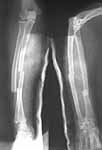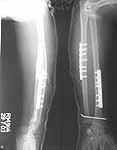

Date: Tue, 29 Jul 2003 20:48:18 +0530
Subject: Both Bones Forearm + DRUJ injury
This middle aged male presented with this compound Galeazzi injury after a road accident. Proximal segment of the radial fracture had come out and gone back. Minimal contamination and presented in about four hours after the injury.
 |
 |
I will be happy to hear the group's thoughts on stabilising the forearm especially the distal radioulnar joint.
Thanks in advance
DR T I GEORGE.
Date: Tue, 29 Jul 2003 21:06:00 +0530
From: rajesh
The radius looks to have shortened enough to account for the DRUJ problem. Once you regain the radial length,the DRUJ will reduce to its original position.
Date: Tue, 29 Jul 2003 21:50:50 +0600
From: Alexander Chelnokov
Hello Dr. George
DTIG> come out and gone back. Minimal contamination and presented in
about four hours after the injury. I will be happy to the groups thoughts on stabilising the forearm
especially the distal radioulnar joint.
Just stabilize both bones by any operative method routinely used in your settings for forearm shaft fractures, and that's all. Proper length of the bones will provide normal DRUJ configuration.
Best regards,
Date: Tue, 29 Jul 2003 16:11:53 +0000
From: Jeff Richmond
Looks like a routine both-bones forearm fracture. Anatomic reduction and internal fixation by standard compression plating should restore complete stability, after appropriate I&D. Examine the DRUJ at the conclusion of the procedure- most of the time it is fine.
Jeff Richmond
Date: Tue, 29 Jul 2003 23:47:57 +0530
From: DR T I GEORGE
Dear Dr Alex,
I think I have not made myself clear. I fully agree with your statement of realigning both bones to it's length which will give the normal configuration to DRUJ. But what are the thoughts on stabilising DRUJ which are not stable on rotations???
DR T I GEORGE.
Date: Tue, 29 Jul 2003 17:19:05 -0600
From: Thomas A. DeCoster
This is NOT the injury described by Galeazzi and the use eponyms often leads to miscommunication rather than improved communication.
Tom DeCoster
Date: Wed, 30 Jul 2003 09:30:15 +0600
From: Alexander Chelnokov
Hello Dr. George,
DTIG> configuration to DRUJ. But what are the thoughts on stabilising DRUJ which are not stable on rotations???
I doubt about clinically significant DRUJ instability after the proper shaft fixation in the case, but if still it revealed i would use some kind of brace or plaster cast for 3 weeks.
Best regards,
Date: Wed, 30 Jul 2003 07:42:47 -0400
From: James Carr
TI
This injury is analogous to the type IV Monteggia where the radial shaft is broken in addition to the radial head dislocation. In this case, its a Galeazzi with fx of the ulna shaft. I don't know if I have seen one like this. As stated by numerous people, the DRUJ is usually stable once the bones are anatomic, and no real treatment for the DRUJ is needed. If it were unstable,the distal ulna is out dorsally, which usually means it reduces with supination. If it is unstable even after supination, I will pin it percutaneously, as I have not had success trying to stabilitze these with open repair alone(eg with open fx where I explored the DRUJ).
Jim Carr
Date: Wed, 30 Jul 2003 07:38:53 -0500
From: Frederic B. Wilson, M.D.
Tom,
Whether we argue that this is a Galeazzi fracture (radius w/ obligate distal radioulnar joint dislocation) or a Galeazzi variant (above w/ concomitant fracture of the ulna in addition) is not the issue. I would be much more interested in what you would do to treat the DRUJ instability.
Some have opined that simply fixing the both bone forearm fracture would be sufficient. My experience has been that placing the forearm in neutral pronation/supination after fixing the fractures and then reducing the DRUJ and holding it with a percutaneous K-wire for four weeks is more reliable.
What do you think?
Date: Wed, 30 Jul 2003 19:55:08 +0530
From: DR T I GEORGE
Friends,
I think now we have been caught with two issues.
1) Nomenclature. I am not aware of anyone classifying this type of injuries unlike Monteggia injuires(I am not the best person to comment on literature). Hence probably we may call it a Galeazzi variant in the absence of any classification. Will be happy to know the comments from others.
2) DRUJ management. In this case which I presented, I found minimal bone loss from the radial fracture site which was compound. However after stabilising it, the DRUJ was reduced in supination but dislocated in pronation. I have put a K wire in the reduced position and given a external above elbow support. I will post the pictures later.
I found the 9th edition of Campells Operative Orthopaedic Surgery mentioning this K wire method and recommending it to be kept for six weeks. However I will be happy to get further inputs from the experience of list members.
Date: Wed, 30 Jul 2003 11:52:45 EDT
From: Tadabq
I look forward to the promised xray of DRUJ instability after plating of radius and ulna shaft fracture.
"Usually" the DRUJ is not unstable after ORIF of radius and ulna fractures. In the unusual cases where I thought there was instability (clinically with "piano keying" or radiographically on the lateral of the wrist) I have immobilized the forearm in supination for 3 weeks. That worked.
I have used DRUJ pinning with two .062 K wires for OTHER injury patterns that included DRUJ instability (radius shaft fx + DRUJ dislocation ("Galeazzi"); distal radius fx + DRUJ instability, distal ulna fx + DRUJ instability, DRUJ instability alone,...)
TDeCoster
Date: Wed, 30 Jul 2003 10:58:27 -0500
From: Anglen, Jeffrey
Dr. George
Can you send post-op images?
JOA
Date: Wed, 30 Jul 2003 21:41:12 +0530
From: DR T I GEORGE
Tom(I hope I can adrress you like it),
I wish I had the instability picture. It was seen clinically and on the Image intensifier monitor. Sorry no permanent record. So you have only my word for it. The post op X ray, I will have to get from hospital and hope to post it tomorrow.
Date: Wed, 30 Jul 2003 15:37 EST
From: Bill Burman
See OTA BFC References from Michael McKee and Gerald Lang and Laura Prokuski
Alex,
"I doubt about clinically significant DRUJ instability after the proper shaft fixation in the case, but if still it revealed i would use some kind of brace or plaster cast for 3 weeks."
A while ago on another case, you would settle for nothing less than locking up the DRUJ with an Ilizarov for several months. Is it possible to get any follow-up on that most interesting case of an anesthesiologist (who is obliged to twist knobs for a living)?
Date: Wed, 30 Jul 2003 17:22:33 -0400
From: James Carr
1) Hence probably we may call it a Galiazzi variant in the absence of any classification.
You are right on all accounts. Its definitely a Galeazzi equivalent.
Others may have seen, but I never have.
Date: Thu, 31 Jul 2003 21:37:13 +0530
From: DR T I GEORGE
Friends,
I think Bill has ended the controversy on nomenclature from his links to basic fracture courses. Hence this injury is "fracture both bones with DRUJ disruption".
I do agree with James Carr that this is not a common injury but I do remember coming across this once in a while. In fact that is the reason I was trying to get the thoughts of the group on DRUJ disruption mamnagement.
Collective experience does help a lot.
I am attaching the post op pictures and I would welcome your comments. I am keeping an elective cancellous bone graft if required in the future plan.
 |
DR T I GEORGE.
Date: Sun, 3 Aug 2003 22:49:17 EDT
From: Aobonedoc
Plate the radius and ulna (assuming skin allows), the evaluate the DRUJ with pinning if unstable.
Sincerely and respectively,
M. Bryan Neal, MD
Arlington Orthopedics and Hand Surgery Specialists, Ltd.
Arlington Heights, Illinois 60005
Date: Mon, 4 Aug 2003 08:10:20 -0400
From: James Carr
Postops look fine. I see you left the pin through the far cortex. I like this as it helps pin removal in case it breaks. Sometimes makes removal a bit harder though.
James B. Carr, MD
Palmetto Health Orthopedics
Date: Mon, 4 Aug 2003 12:47:01 EDT
From: Tadabq
I agree that the postop radiographs look good. The radius and ulna appear well aligned and the DRUJ alignment and pin position are good. The management seems excellent and I would expect a good outcome.
The wrist appears slightly ulna negative. Do you have wrist films? Do you have comparison films of the contralateral wrist to determine this patient's pre-injury ulnar variance? The radius shaft fracture might be a tiny bit distracted.
Unfortunately the films showing DRUJ instability after plating are not available (C-arm only). How this treatment compares to other treatments also not known.
TD
Date: Tue, 5 Aug 2003 22:10:37 +0530
From: DR T I GEORGE
Dear Tom,
Thanks for the compliments on the case.
Sorry, I do not have the x-ray of the other wrist and the patient was sent home just before your mail. Would try for it during follow up. The radius fracture on reduction showed bone loss on the medial border though lateral aspect had good contact when looked from the volar aproach. However when I tried compression on the plate, there seemed to be overiding (again from what I could see from the volar aspect). However I saw that the post op xray appears to give an impression of distraction. I am keeping an option of elective bonegraft just in case the fracture refuses to show signs of healing by 6-8 weeks.
Regards.
DR T I GEORGE.